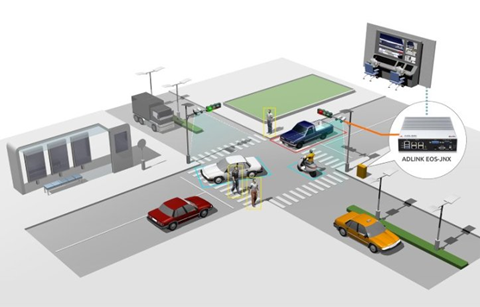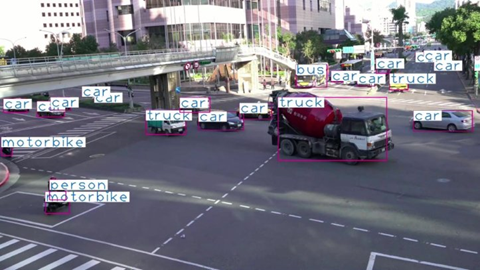ADLINK's EOS-JNX-I machine vision system supports optimized traffic signal management
Using artificial intelligence (AI) to create modern smart city solutions
ADLINK, a leading global provider of edge computing solutions, provides artificial intelligence (AI)-enabled machine vision systems, EOS-JNX-I, to help a smart transportation solution provider optimize the traffic light monitoring system that helps improve traffic flow and enable the development of modern smart cities. The project helps reduce urban traffic congestion, improve air quality, and reduce commuters' waiting time during peak hours, fully improving the city's traffic efficiency and people's livelihood environment.

Transportation is the artery of social operation. However, at certain times and places with large numbers of people and vehicles, this artery will inevitably be blocked. AI smart traffic lights can alleviate this situation . In the smart transportation plan of a certain heavyweight city, AI technology is used to reduce the time vehicles wait for traffic lights by 20%. Xu Kaixiang, senior product manager of ADLINK's Intelligent Vision Business Center, said: "AI smart traffic light control technology is one of the most sensitive intelligent transportation systems. This technology can greatly reduce the suffering of pedestrians from traffic jams."
The traffic lights in cities now have a system that has been in operation for many years. The system database contains information about the flow of people and vehicles accumulated over the years. The Transportation Bureau can use this data to evaluate and set the number of seconds for traffic lights at each intersection, and adjust the traffic lights manually according to the situation in sections prone to congestion during peak traffic hours . This operating model does help ease urban traffic to a certain extent, but as the number of people and vehicles in the city increases, the traffic light system must become smarter, and AI will play a key role here.
AI traffic lights can autonomously determine intersection conditions
According to the forecast of research organization Emergen Research, due to the growing demand for efficient traffic management in various cities, the global AI transportation market will reach US$7 billion in 2028. All countries have relevant cases of using adaptive traffic signals, hoping to increase urban traffic efficiency, reduce urban carbon emissions, and allow fire trucks, ambulances and other vehicles to have priority passage.
But specifically, how will the intersections with AI smart traffic light control systems be different from the current ones? Xu Kaixiang explained that at intersections with such adaptive traffic lights, the camera of the traffic light will first transmit the image to the edge computing server inside the light device, and the edge computing server will judge the current situation in real time to control the traffic light, making the flow of people and vehicles on the road smoother.
In addition, the computer will also learn autonomously through its internal AI algorithm, making traffic light control more and more precise. Compared with the existing traffic light control system with a fixed number of seconds, the AI system can automatically adjust traffic lights according to the conditions at the intersection. It is more suitable for intersections with changing conditions and can judge the current traffic flow to make real-time adjustments.

Solve the problem of processing huge image information of traffic lights
The application scenarios of intelligent traffic signals seem beautiful, but it is not easy to achieve this goal. There are three major problems that need to be solved.
First, the environment in which traffic light equipment is located is harsh. The high and low temperatures in winter and summer will affect the computer performance of traffic lights at intersections. Secondly, sufficient computing power is required to process huge amounts of image information in real time. Thirdly, equipment scattered across the site is difficult to monitor and maintain. In the past, it was common for cameras to lose power, resulting in the inability to obtain surveillance images.
To solve this dilemma, ADLINK launched EOS-JNX, an edge computing solution designed specifically for intelligent transportation. Kaixiang Xu, senior product manager of ADLINK's Intelligent Vision Business Center, said: "ADLINK has been deeply involved in the field of industrial computers for many years. Performance and stability are already basic skills. The wide temperature design of EOS-JNX is sufficient to cope with the challenges of harsh environments."
As for computing power, this device uses NVIDIA's Jetson Xavier NX AI module vision system. Xu Kaixiang pointed out that NVIDIA is a major manufacturer of AI computing processors, and ADLINK Technology is a long-term partner of NVIDIA. Therefore, relevant information can be obtained in the early stages of advanced technology research and development to ensure that product functions are ahead of the market.
ADLINK EOS-JNX has two other advantages in traffic light control systems: easy AI deployment and easy management and maintenance. EOS-JNX has a 4-channel GigE interface. Through this mainstream interface design for security monitoring systems, the system can quickly connect to IP surveillance cameras and transmit images to the Jetson Xavier NX AI module visual system to analyze the images using AI algorithms. In addition, system operators can also use the transmission access ports provided by EOS-JNX to upload images to the NVR, and existing monitoring systems can also be upgraded.

In terms of management and maintenance, the Smart PoE design of EOS-JNX is worth mentioning. PoE is a common network communication technology for surveillance systems. The main feature of this technology is that a single cable has both communication and power transmission functions, which greatly simplifies the wiring architecture of surveillance cameras. Traditional PoE can only transmit data and power, while EOS-JNX's Smart POE further adds remote control functions, making equipment monitoring and maintenance easier. System administrators can use Smart POE to control the power supply status of surveillance cameras. When the device loses power without warning, it will also send a real-time notification and can be restarted remotely to restore power in a short time to maintain normal operation of the device.
PoC projects can be built within two weeks
In addition to EOS-JNX, ADLINK has also launched EVA SDK edge vision analysis software to help system operators quickly introduce intelligent systems. This is because the professional requirements for AI are quite high, which makes most companies unable to invest in development. EVA SDK allows practitioners without relevant expertise to easily and quickly set up application systems. Through AI hardware devices pre-loaded with EVA SDK, system operators can establish a PoC project in as little as two weeks.
Improving transportation efficiency through intelligence has become a key policy for cities. AI that can learn autonomously will play a key role in intelligent transportation systems. ADLINK will continue to develop software and hardware solutions that can lower the threshold for AI development, assisting relevant departments to easily deploy in the transportation field and jointly create an intelligent transportation future.
Previous article:Synopsys drives industry innovation to fasten the seat belts of intelligent connected vehicles
Next article:ON Semiconductor and Ride Vision partner to provide advanced safety solutions for motorcycle riders
- e-Network Community and NXP launch Smart Space Building Automation Challenge
- The Internet of Things helps electric vehicle charging facilities move into the future
- Nordic Semiconductor Launches nRF54L15, nRF54L10 and nRF54L05 Next Generation Wireless SoCs
- Face detection based on camera capture video in OPENCV - Mir NXP i.MX93 development board
- The UK tests drones equipped with nervous systems: no need to frequently land for inspection
- The power of ultra-wideband: reshaping the automotive, mobile and industrial IoT experience
- STMicroelectronics launches highly adaptable and easy-to-connect dual-radio IoT module for metering and asset tracking applications
- This year, the number of IoT connections in my country is expected to exceed 3 billion
- Infineon Technologies SECORA™ Pay Bio Enhances Convenience and Trust in Contactless Biometric Payments
- LED chemical incompatibility test to see which chemicals LEDs can be used with
- Application of ARM9 hardware coprocessor on WinCE embedded motherboard
- What are the key points for selecting rotor flowmeter?
- LM317 high power charger circuit
- A brief analysis of Embest's application and development of embedded medical devices
- Single-phase RC protection circuit
- stm32 PVD programmable voltage monitor
- Introduction and measurement of edge trigger and level trigger of 51 single chip microcomputer
- Improved design of Linux system software shell protection technology
- What to do if the ABB robot protection device stops
- Allegro MicroSystems Introduces Advanced Magnetic and Inductive Position Sensing Solutions at Electronica 2024
- Car key in the left hand, liveness detection radar in the right hand, UWB is imperative for cars!
- After a decade of rapid development, domestic CIS has entered the market
- Aegis Dagger Battery + Thor EM-i Super Hybrid, Geely New Energy has thrown out two "king bombs"
- A brief discussion on functional safety - fault, error, and failure
- In the smart car 2.0 cycle, these core industry chains are facing major opportunities!
- The United States and Japan are developing new batteries. CATL faces challenges? How should China's new energy battery industry respond?
- Murata launches high-precision 6-axis inertial sensor for automobiles
- Ford patents pre-charge alarm to help save costs and respond to emergencies
- New real-time microcontroller system from Texas Instruments enables smarter processing in automotive and industrial applications
- Fluke High Resolution Thermal Imager - Even the smallest details are captured! Free trial registration is open
- The capacitor on the PCBA cracked and short-circuited. How could it be the design's fault?
- 【Bluesun AB32VG1 RISC-V Evaluation Board】Development of example programs
- 2nd day to go!! Pre-registration for the prize live broadcast | ON Semiconductor image sensors help the automotive, machine vision and artificial intelligence fields....
- 【AT-START-F425 Review】USB to CAN Preview Post
- Abnormal sound from the front transformer of the power factor circuit
- Packaging issues of double-row pluggable connectors
- Japanese auto parts giant exposed to large-scale fraud for 20 years! Affecting 10 Japanese automakers...
- 【AT32WB415 Review】03 SPI Drive TFT LCD Screen
- [Environmental Experts on Smart Watches] Part 2: ON Semiconductor IDE Environment Construction

 Hardware Accelerators in Autonomous Driving
Hardware Accelerators in Autonomous Driving ICCV2023 Paper Summary: Vision Applications and Systems
ICCV2023 Paper Summary: Vision Applications and Systems
















 京公网安备 11010802033920号
京公网安备 11010802033920号